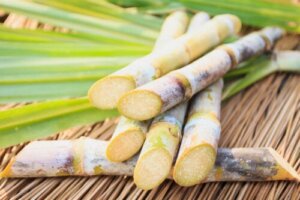Sugarcane: Nutritional Value and Properties


Written and verified by the nutritionist Maria Patricia Pinero Corredor
For many, sugarcane is an agricultural fruit that represents the essential raw material in the production of the most popular and widely used natural sweetener: table sugar.
In addition to being the main raw material for making refined white sugar and other types of sweeteners, such as panela or brown sugar, it also provides some benefits that few of us know. Even in cooking, it is a classic ingredient in different recipes.
Stay with us to learn about its nutritional value and the properties that make it a food with broad health benefits.
What is sugarcane?
Sugarcane is a herbaceous crop with a woody stem that belongs to the grass family and can grow up to 5 meters tall. Its scientific name is Saccharum officinarum L. and the source of table sugar.
It is native to New Guinea and people first cultivated it in Southeast Asia and Western India. From here it reached Spain in the 9th century and in the 15th century it spread to the Americas. Today, people grow it in many tropical and subtropical countries around the world.
As a stem, you can consume it peeled or juiced and has some nutrients that make it an excellent choice. It is a crop that provides food security for the people, as it is economical, viable, ecological and self-energy.
Types of sugarcane
Sugarcane has 4 varieties:
- Cristalina: it has stalks that can measure up to 6 meters in height. It has dark leaves surrounded by a layer of whitish hairs. It is more resistant to extreme conditions, but is harder.
- Veteada: it has a striped appearance of red, violet and yellow. It is smaller than the previous one, reaching about 3 and a half meters. It is very resistant to cold.
- Criolla: it is extremely juicy and has one of the highest sucrose concentrations.
- Violet: it owes its name to the color of its stems and its leaves are of an intense green color. It resists low temperatures well and is less juicy than the previous ones.

Nutritional value of sugarcane
The chemical composition of sugarcane was evaluated by a group of agronomists, who found that it is rich in carbohydrates, with 56%. Of that amount, 28 grams are insoluble dietary fiber, such as cellulose, hemicellulose and lignin.
The other half of the carbohydrates are simple sugars, which makes it an energy source par excellence. However, its protein value is low, since the maximum content is 1.4%.
On the other hand, several by-products are extracted from sugarcane and each one has a different nutritional value. Thus, we will review the components of sugarcane juice, bagasse and panela.
Sugarcane juice
Sugarcane juice is viscous, opaque and darkens in color after extraction. This is due to a chemical reaction between the proteins in the juice and its sugars.
Brown or dark green compounds called melanoidins are formed. From the juice, sucrose crystals are obtained, from which table sugar is prepared.
Its nutritional value is characterized by a high content of total solids (between 15 to 20%), of which 80% is sucrose. It is therefore highly digestible and is considered almost 4 times more energetic than a cereal.
On the other hand, a group of experts evaluated the vitamin C content in the juice after pasteurization, finding that it remained at 47 milligrams per 100 milliliters of sugarcane juice. This is considered important because of the positive health effects of vitamin C.
Panela
Panela is a solid product obtained by concentrating the sugar present in sugarcane juice. Therefore, it has a high proportion of sucrose, reaching values close to 80%. It also contains 15% fructose.
This makes it highly energetic, providing 350 calories per 100 grams. Although it is still lower than refined sugar, which is around 400 calories.
Bagasse
Although bagasse is a by-product obtained from the extraction of sugarcane juice, and is not directly consumed by the population, the presence of certain components and bioactive substances make it interesting for its addition in different products.
For example, bagasse is a source of insoluble fiber, such as cellulose, hemicellulose and lignin. These represent between 20 and 45 % of the entire product.
In addition, the mineral value is 2.5 %, including calcium, magnesium, potassium and iron. While proteins have a value of 2.4%.
Sugarcane properties
The properties of sugarcane depend on its nutritional value and the presence of certain active components, which are mentioned below.
It is a source of antioxidants
Both sugarcane juice and bagasse provide a variety of bioactives that act as antioxidants, capable of inhibiting or delaying oxidation in the body by blocking free radicals.
Bagasse contains anthocyanins, flavonoids and polyphenols that have been studied for their antioxidant action. They act as antimutagenic and possibly anticancer agents.
Sugarcane juice, on the other hand, contains a high proportion of vitamin C, flavonoids and cinnamic acids. One glass of sugarcane juice contains 40 milligrams of phenolic compounds, which represents an important source of dietary antioxidants.
A group of researchers measured polyphenols in different varieties of sugarcane juice and showed that all were able to protect against radiation-induced DNA damage. The study also revealed the juice’s ability to scavenge free radicals and inhibit lipid peroxidation.
In addition, vitamin C helps with collagen maintenance, liver detoxification and the prevention of some types of cancer and cardiovascular disease.
Sugarcane provides sufficient dietary fiber
The inclusion of dietary fiber from sugarcane bagasse in the formulation of novel foods has been studied. Some technological processes have made it possible to improve its functional properties. We know that cellulose and hemicellulose can control blood sugar and cardiovascular disease risk factors.
It could improve sports performance
Sugarcane juice is a natural beverage that, according to some studies, can increase blood sugar levels during and after exercise. This, compared to a pure water beverage and a sports drink.
In addition, there were no differences between sugarcane juice with other beverages for exercise time, heart rate and plasma volume. Therefore, you can use it indistinctly in any physical activity.

Chewing sugarcane can have an anticariogenic effect
Diet is one of the main factors that can prevent tooth decay. A healthy diet is closely related to the promotion of oral health.
It has been observed that a group of children who live in sugarcane growing areas and who chew sugarcane as a dietary habit are almost 50% less likely to suffer from dental caries. While children who do not have this habit presented greater health problems in their teeth.
Possible antibacterial and antiviral prophylactic effects of sugarcane
Some studies report that sugarcane juice has a prophylactic effect, as it promotes resistance to bacterial and viral infections. In this respect, a group of mice ate sugarcane juice after exposure to the rabies virus.
The control group ate only distilled water. Those that ate sugarcane juice survived, while the rest of the mice died.
Thus, the researchers concluded that sugarcane juice extract has a prophylactic effect. It prevents pathogens from multiplying.
However, these results didn’t happen in humans.
How to consume sugar cane?
Undoubtedly, the best way to consume sugarcane is through its juice. To obtain a glass of 250 milliliters you must peel about 6 pieces of sugar cane, removing the hardest external part. Then you take them to the extractor, strain it and enjoy it.
Do not forget that, despite the benefits of sugarcane juice, the amount of sugar and calories cannot go unnoticed. So our recommendation is not to ingest more than 2 glasses a day, especially if you are trying to follow a low calorie diet to maintain or lose weight.
All cited sources were thoroughly reviewed by our team to ensure their quality, reliability, currency, and validity. The bibliography of this article was considered reliable and of academic or scientific accuracy.
- Aguilar-Rivera, N. (2012). Paradigma de la diversificación de la agroindustria azucarera de México. Convergencia, 19(59), 187-213. Disponible en: http://ref.scielo.org/nb2zv4
- Lagos-Burbano, Elizabeth; Castro-Rincón, Edwin Caña de azúcar y subproductos de la agroindustria azucarera en la alimentación de rumiantes. Agronomía Mesoamericana, vol. 30, núm. 3, 2019 Universidad de Costa Rica, Costa Rica Disponible en: https://www.redalyc.org/articulo.oa?id=43760145020 DOI: https://doi.org/10.15517/am.v30i3.34668
- Solís-Fuentes, J., Calleja-Zurita, K., Durán-de-Bazúa, M. (2010). Desarrollo de jarabes fructosados de caña de azúcar a partir del guarapo. Tecnol. Ciencia Ed. (IMIQ), 25, 1, 53-62. Disponible en: https://www.redalyc.org/pdf/482/48215094007.pdf
- Karmakar, Richa & Ghosh, Amit & Gangopadhyay, Hiranmoy. (2010). Asian Journal of Food and Agro-Industry Study on the nutritional and microbiological changes of sugarcane juice and determination of optimum conditions during pasteurization. Asian Journal of Food and Agro-Industry. 3. 453-461. Disponible en: https://www.researchgate.net/publication/297567783_Asian_Journal_of_Food_and_Agro-Industry_Study_on_the_nutritional_and_microbiological_changes_of_sugarcane_juice_and_determination_of_optimum_conditions_during_pasteurization/citation/download
- PAULINA OBANDO. UNIVERSIDAD TÉCNICA DEL NORTE FACULTAD CIENCIAS DE LA SALUD TECNOLOGÍA EN GASTRONOMÍA. La panela, valor nutricional y su importancia en la gastronomía. 2010. Disponible en: http://repositorio.utn.edu.ec/bitstream/123456789/2247/2/ARTICULO%20CIENTIFICO%20PANELA.pdf
- Cardona, C., Quintero, J. y Paz, I. (2010). Production of bioethanol from sugarcane bagasse: Status and perspectives. Bioresource Technology, 101, 4754-4766. Disponible en: https://www.sciencedirect.com/science/article/pii/S0960852409015089
- Instituto de Información Científica y Tecnológica, Cuba. Hombre, Ciencia y Tecnología. Caracterización nutricional de los residuos orgánicos en la caña de azúcar del cantón La Troncal. vol. 25, núm. 2, 2021. [email protected]
- Luna-Guevara, M. y Delgado-Alvarado, A. (2014). Importancia, contribución y estabilidad de antioxidantes en frutos y productos de tomate (Solanum lycopersicum L). Avances en Investigación Agropecuaria, 18, 1, 51-66. Disponible en: http://ww.ucol.mx/revaia/portal/pdf/2014/enero/5.pdf
- Kadam, U., Ghosh, S., De, S., Suprasanna, P., Devasagayam, T. y Bapat, V. (2008). Antioxidant activity in sugarcane juice and its protective role against radiation induced DNA damage. Food Chemistry, 106, 3, 1154-1160. Disponible en: https://www.sciencedirect.com/science/article/pii/S0308814607007479
- Martínez-Bustos, F., Viveros-Contreras, R., Galicia-García, T., Nabeshima, E. y VerdaletGuzmán, I. (2011). Some functional characteristics of extruded blends of fiber from sugarcane bagasse, whey protein concentrate, and corn starch. Ciênc. Tecnol. Aliment. Campinas, 31, 4, 870- 878. Disponible en: https://www.scielo.br/j/cta/a/hK6X78XMm4tnwh8hbycsXqg/?format=pdf&lang=en
- Kalpana, K., Rishi, P., Lakshmi, D. y Lal, G. (2013). The effects of ingestion of sugarcane juice and commercial sports drinks on cycling performance of athletes in comparison to plain water. Asian J Sports Med, 4, 3, 181-189. Disponible en: https://www.ncbi.nlm.nih.gov/pmc/articles/PMC3880661/#:~:text=Results,blood%20lactate%20and%20plasma%20volume.
- Singh, A., Grover, H. and Bhatia, H. (2013). The study of cariogenicity of raw sugarcane in 12- year-old children in Punjab, India. J Oral Health Comm Dent, 7, 1, 37-43. Disponible en: https://www.researchgate.net/publication/334512423_The_Study_of_Cariogenicity_of_Raw_Sugarcane_in_12-year-old_Children_in_Punjab_India
- Koge, K., Saska, M. y Chi, C. (2005). Chapter 18 E1. Antioxidants and other functional extracts from sugarcane. En Asian Functional Foods. John Shi, Fereidoon Shahidi, Chi-Tang Ho. pp 672. Disponible en: https://books.google.co.ve/books/about/Asian_Functional_Foods.html?id=vErMBQAAQBAJ&redir_esc=y
This text is provided for informational purposes only and does not replace consultation with a professional. If in doubt, consult your specialist.








